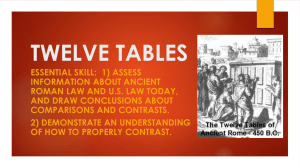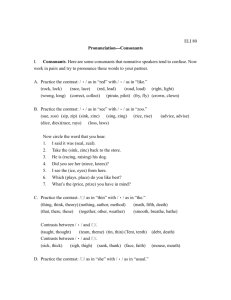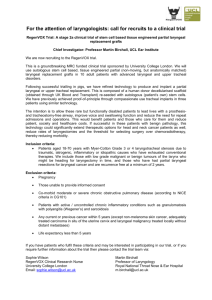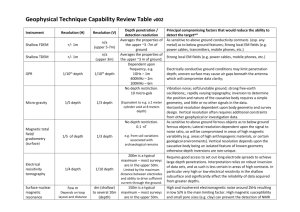24.961 Contrast and Perceptual Distinctiveness
advertisement
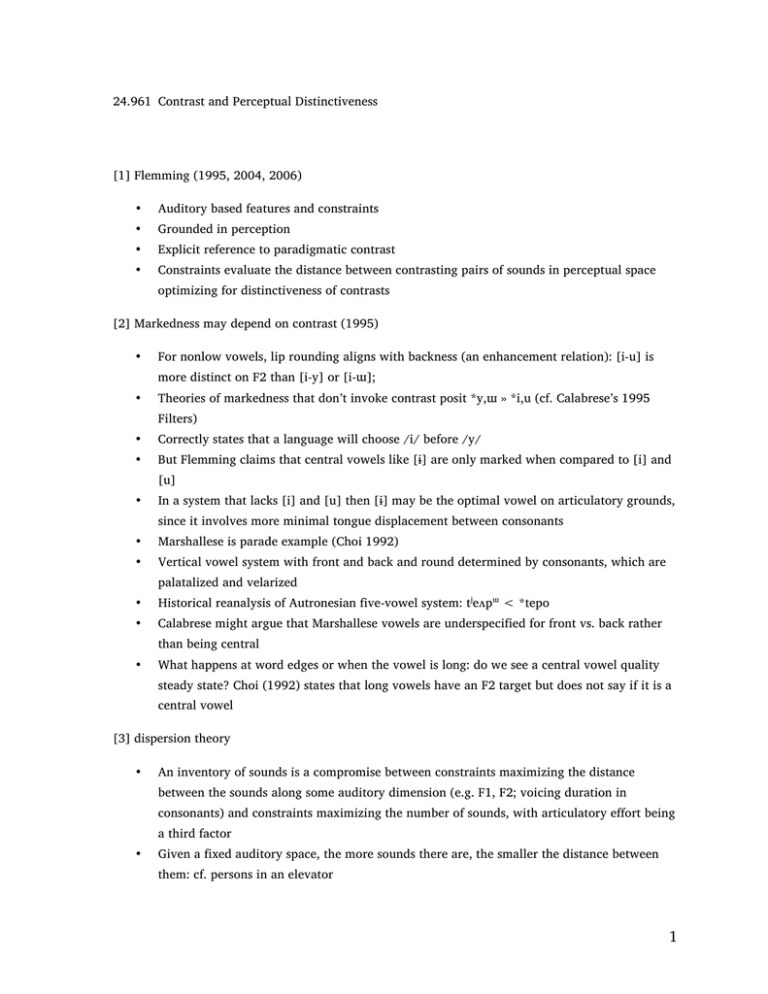
24.961 Contrast and Perceptual Distinctiveness
[1] Flemming (1995, 2004, 2006)
•
Auditory based features and constraints
•
Grounded in perception
•
Explicit reference to paradigmatic contrast
•
Constraints evaluate the distance between contrasting pairs of sounds in perceptual space
optimizing for distinctiveness of contrasts
[2] Markedness may depend on contrast (1995)
•
For nonlow vowels, lip rounding aligns with backness (an enhancement relation): [i-u] is
more distinct on F2 than [i-y] or [i-ɯ];
•
Theories of markedness that don’t invoke contrast posit *y,ɯ » *i,u (cf. Calabrese’s 1995
Filters)
•
Correctly states that a language will choose /i/ before /y/
•
But Flemming claims that central vowels like [i] are only marked when compared to [i] and
[u]
•
In a system that lacks [i] and [u] then [i] may be the optimal vowel on articulatory grounds,
since it involves more minimal tongue displacement between consonants
•
Marshallese is parade example (Choi 1992)
•
Vertical vowel system with front and back and round determined by consonants, which are
palatalized and velarized
•
Historical reanalysis of Autronesian five-vowel system: tjeʌpɯ < *tepo
•
Calabrese might argue that Marshallese vowels are underspecified for front vs. back rather
than being central
•
What happens at word edges or when the vowel is long: do we see a central vowel quality
steady state? Choi (1992) states that long vowels have an F2 target but does not say if it is a
central vowel
[3] dispersion theory
•
An inventory of sounds is a compromise between constraints maximizing the distance
between the sounds along some auditory dimension (e.g. F1, F2; voicing duration in
consonants) and constraints maximizing the number of sounds, with articulatory effort being
a third factor
•
Given a fixed auditory space, the more sounds there are, the smaller the distance between
them: cf. persons in an elevator
1
!
Sound are located in a multi-dimensional perceptual space where perceptual
Forsavow
asssum
somceoul
grd
idbe
with
idieeadlizteodm
spoarceet;ha
F2nin
barckesl;l.F1 doubles bark frequencies
e•s, the
me eIlPs A
ymebol
appl
one
a ranked set of
een contrasting sounds.
ints are opposed by two
general (families of) constraints:
Minare
aD
xiism
ze t1he
beVowels
rt-of
astspecified
. ist-F2:3by
! Perceptual dimensions
n-ary
features.
feature
matrices: [F1
• ! *M
t-iF2:
» *num
MinDis
F2:c2ont
» are
*rMi
nsD
» ....
» *MinDist-F2:6:
this 1,
markedness
!
M
ini
m
i
z
e
a
r
ti
c
ul
a
t
or
y
e
f
fort.
F2 6, …].
hierarchy optimizes the distance between sounds along some auditory dimension
Ma
numb
erbe
ofrcof
ontcront
astsra(v
• Ma
xixmimi
izezethe
num
stosw. els): more information can be stored and transmitted per
uni
t ofesspa
ce tor
timnc
e, ybut
t tIhe
aterapos
sibl
!O
ppos
the
ende
of aM
NDcIos
STt of
to gfarevor
few
meacxionf
mauslliyondistinct contrasts.
• Sound inventories arise from embedding Maximize Contrasts somewhere within the MinDist
! With more contrasting sounds, each sound spoken can distinguish more words (and thus
nkinys
g more information).
onve
cra
• ! IEr
taebl
w: de
reas
e eac
Min
distts=
onest
mrplateaminent
deabe
s alopos
iticve
cons
trahint
tha
elFe2ctval
s tuhee blayrge
3
Japran
r nt
Kor
• not
Firsbe
t tabl
elghe
e, sdeccon
d tfroai
en eealiumfor
inaftievde-vow
by hi
-raesnke
ons
s)ean
.
inventory of contrasts (that has
Flemming, Edward. “Contrast and Perceptual Distinctiveness.” In The Phonetic Bases of Markedness. Edited by Bruce Hayes,
! Kirchner,
INDIST
Robert
and Donca Steriade. Cambridge University Press, 2004. © Cambridge University Press. This content is
excluded from our Creative Commons license. For more information, see http://ocw.mit.edu/help/faq-fair-use/.
M
constraints impose the preference for contrasts between front unrounded and
back rounded vowels.
! If there is no F2 contrast then these constraints are irrelevant (cf. vertical vowel
2
inventories).
16. Differences on multiple dimensions can combine to contribute to the overall distinctiveness
•
Candidate d is winner in second tableau; by moving Max Contrasts up (leftward) in the
MinDist hierarchy, we derive more vowels but at the cost of closer spacing; by moving down
(rightward) we derive fewer vowels but with larger spacing
•
Korean has /i/ vs. /ɨ/ vs. /u/ while Japanese has /i/ vs. /u/ (though /u/ is phonetically
quite front, at least in Tokyo dialect; if it really is /ɯ/ then we would have to appeal to
articulatory effort to choose /ɯ/ over the auditorily more optimal /u/. One the other hand,
phonologically Jap /u/ patterns with labials, causing /h/ to be realized as [ɸ]). Perhaps F3 is
relevant; see discussion of Cantonese below.
Vowel height (F1)
•
Standard Italian (i,u, e,o,ɛ,ɔ,a) arises from ranking MinDist F1:2 » Max Contr » MinDistF1:3
Flemming, Edward. “Contrast and Perceptual Distinctiveness.” In The Phonetic Bases of Markedness. Edited by Bruce Hayes,
Robert Kirchner, and Donca Steriade. Cambridge University Press, 2004. © Cambridge University Press. This content is
excluded from our Creative Commons license. For more information, see http://ocw.mit.edu/help/faq-fair-use/.
•
Spanish demotes Max Contrast for greater dispersion: MinDist F1:3 » Max Contr »
MinDistF1:4
Flemming, Edward. “Contrast and Perceptual Distinctiveness.” In The Phonetic Bases of Markedness. Edited by Bruce Hayes,
Robert Kirchner, and Donca Steriade. Cambridge University Press, 2004. © Cambridge University Press. This content is
excluded from our Creative Commons license. For more information, see http://ocw.mit.edu/help/faq-fair-use/.
•
Arabic {i,u,a}
Flemming, Edward. “Contrast and Perceptual Distinctiveness.” In The Phonetic Bases of Markedness. Edited by Bruce Hayes,
Robert Kirchner, and Donca Steriade. Cambridge University Press, 2004. © Cambridge University Press. This content is
excluded from our Creative Commons license. For more information, see http://ocw.mit.edu/help/faq-fair-use/.
[4] neutralization of contrasts
•
In unstressed syllables Standard Italian seven vowels reduce to five, with loss of the
distinction between open and closed mid vowels
3
•
EF sees this as a response to increased artic effort that would be required to realize vowels in
shorter time span of unstressed syllables
•
Chief evidence is that low vowel /a/ is raised to [ɐ]; this encroaches on the vowel space; if
the same Min-Dist and Artic effort constraints that define the stressed vowel/lexical
inventory are imposed, then the number of distinctions decreases since the grammar now
chooses the five-vowel system
Flemming, Edward. “Contrast and Perceptual Distinctiveness.” In The Phonetic Bases of Markedness. Edited by Bruce Hayes,
Robert Kirchner, and Donca Steriade. Cambridge University Press, 2004. © Cambridge University Press. This content is
excluded from our Creative Commons license. For more information, see http://ocw.mit.edu/help/faq-fair-use/.
Flemming, Edward. “The Role of Distinctiveness Constraints in Phonology.” Massachusetts Institute of Technology,
2006. © Edward Flemming. All rights reserved. This content is excluded from our Creative Commons license.
For more information, see http://ocw.mit.edu/help/faq-fair-use/.
[5] Dispersion and enhancement (Flemming 2006)
•
If dispersion constraints can freely interact with faithfulness and markedness constraints
then the model over-generates: the inventory of contrasting segments should vary with
context and targeted enhancement repairs should be able to rescue contrasts that are
challenged by context (e.g. adding a schwa to final voiced obstruents). Another problem is
an infinite regress: “the wellformedness of a candidate word [pad] might depend on whether
or not [pat] is a possible word. But to determine whether [pat] is a possible word, we have
to determine whether or not is statisfies MinDist constraints, requiring it to be adequately
distinct from its neighbors, and so on”.
•
EF’s claim is that we don’t in general find these effects and the only response to a
nonoptimal contrast is neutralization: in unstressed syllables distinctions are lost and the set
of vowels shrinks rather than shifts (e.g. by introducing length); the only response to final
voiced obstruents is devoicing (loss of contrast towards articulatorily less effortful sound)
•
Proposal is to restrict the role of dispersion constraints to defining the phonemic inventory
that encodes the lexicon and as a final “quality check” on the output of the input-output
mapping in the ESC (Evaluation of Surface Contrast) module; in particular, dispersion
constraints cannot interact with (be ranked with) the markedness and faithfulness
constraints that define the input-output mapping.
4
•
In the ECS there are (apparently) just the MindDist constraints and a general *Merger
constraint
[6]
Example from Cantonese:
high vowels:
i y
u
UG space:
F2
F3
5
4
3
2
1
i
y
ɨ
ʉ
u
4
3
2
1
i
ɨ
y,u
ɹ
constraint ranking for inventory
MINDIST=
F2:2
or F3:2
(14)
a.
i
!
b. ! i y
c.
iy !
d.
iy "
e.
i
u
u
u
u
u
*!
*!
MAXIMIZE
CONTRASTS
!!!
!!!
!!!!
!!!!
!!!
MINDIST=
F2:3
or F3:3
**!
*
***
***
MINDIST=
F2:4
**
**
*****
*****
Flemming, Edward. “The Role of Distinctiveness Constraints in Phonology.” Massachusetts Institute of Technology,
2006. © Edward Flemming. All rights reserved. This content is excluded from our Creative Commons license.
For more information, see http://ocw.mit.edu/help/faq-fair-use/.
Given an inventory of contrasting segments, the goal is to realize the full inventory of
contrasts in all contexts. So possible underlying forms consist of all sequences of segments from
• front rounded vowels found after dentals and velars but not labials: ti, tu, ty; ki, ku, ky but
the inventory and the goal is to realize these underlying forms faithfully. In some cases
pi, pu, contrasts
*py
underlying
are neutralized because they cannot be realized with sufficient
• could be repaired
by shift to
a new phoneme
-> pɨ) but this
is in general
not found;
distinctiveness
in a particular
context,
as in final(/py/
neutralization
of obstruent
voicing
contrasts.
Following
Flemming
only merger
to [i] (2002), we will analyze the restriction on front rounded vowels in
β
Cantonese
in
similar
terms. Coarticulation
with anofadjacent
labial
renders
[i] too[isimilar
to front
] that is
• in input-output mapping
there is coarticulation
/i/ with /p/
creating
a vowel
rounded
[y], so the contrast is neutralized in this context. In both cases the evaluation of
too close to /y/ and the response is to neutralize the [iB] - [y] contrast; the outcome is
distinctiveness must apply to the surface realizations of the contrasts in order to take contextual
determined by lowering ranking dispersion constraint maximizing distance from [u] and
effects
such as labial coarticulation into account. However, MINDIST and MAXIMIZE CONTRASTS
[i] freely with contextual markedness constraints if we are to account for the
must choosing
not interact
(17) Realization:
relative stability/pin/of inventories*Lacross
contexts.
these two generalizations motivates
ABIAL
IDENT(F2)
IReconciling
DENT(F3)
COARTICULATION
the distinctiona. between Realization
and
Evaluation
of
Surface
Contrasts (ESC). The Realization
*!
pin
*
b.
component maps
an input
string
onto
its
phonetic
realization
while
the ESC assesses the
!
pi n
**!
***
c.
p" n
distinctiveness of contrasts based on these phonetic realizations. The Realization component
incorporates(18)theESC:
contextual markedness constraints that motivate contextual variation in the
MINDIST=
*MERGE
MINDIST=
MINDIST=
/pyn , pin , pun /
F2:2 not include MF2:3
F2:4
realization of contrasts but does
INDIST constraints.
The MINDIST constraints
or F3:2
or F3:3
evaluate the outputs
in
ESC
but
cannot
directly
influence
the realization of a given
pin ,Realization
pun /
/pyn ,of
a.
*!
*
**
pyn pi n pun
input.
!
/pin , pun /
b.
*
pun model to neutralization of front rounding contrasts is illustrated by
piof
n this
The application
/pyn , pun /
c. (15) and (16). It is easier
* to se ethe overall
*! structure of the analysis by
the tableaux in
pyn pun
considering
ESC first
andofthen
turn to the
detailsin of
Realization.
Flemming, Edward.
“The Role
Distinctiveness
Constraints
Phonology.”
Massachusetts Institute of Technology,
2006.
©
Edward
Flemming.
All
rights
reserved.
This
content
is
excluded
from
Commons
license.
The ESC
the same ranking of of
MINDIST
constraints asittheis
Inventory
– there our
is no
re-consider
To evaluate
theemploys
distinctiveness
contrasts
necessary
toCreative
a target
input in
For more information,
see http://ocw.mit.edu/help/faq-fair-use/.
ranking of constraints
between components, although only certain classes of constraints apply in
relation to aeach
setcomponent.
of minimally
contrasting
inputs.
This
setplace
must
also occupies
the same
in the at least contain all input forms that
The initial hypothesis
is that *MERGE
ranking as MAXIMIZE CONTRASTS. This implies that the minimum level of distinctiveness that is
differ from the
target
by changing,
inserting
deleting
a single
5
acceptable
for a contrast
in the inventory should
also be theor
threshold
below which
a surface segment, but generally must
contrast is neutralized.
In
thewill
analysisbe
above,
the smallest acceptable
F3 contrast
must have
a
contain additional
forms
as
discussed
further
below.
Here
we
are
interested
in
the
input
distinctiveness of F3:2 since MINDIST = F3:2 ranks just above MAXIMIZE CONTRASTS (14). If
*M
ERGE occupies
the samevowel
position as adjacent
MAXIMIZE CONTRASTS
the rankingThe
of MINDIST
/pyn/ with aconstraints,
front
rounded
to a inlabial.
contrast set for this input includes
any contextual influence that would reduce the distinctiveness of an F3 contrast
!
!
1
2
3
1
!
2
1
3
2
!
1,2
1,2
1,2
1,2
3
3
3
3
3
Gallagher (2010)
•
two types of cross-linguistic root co-occurrence constraints on laryngeally marked
consonants such as ejectives
•
dissimilatory: C’VCV, CVC’V, CVCV, *C’VC’V (cf. Lyman’s Law in Japanese)
•
assimilatory (less common): *C’VCV, CVC’V, CVCV, *C’VC’V (Chaha)
•
Repair of dissimilation eliminates second ejective; repair of assimilation eliminates C’VC by
distributing
ejection through the root
436 Gillian
Gallagher
pattern
I call ‘mixed ’,*T’-K’
heterorganic
and homorganic
pairs pattern differT-K
(1) a. dissimilation
T’-K
ently. ‘ T-K’ stands for
any
pair
of
heterorganic
consonants,
while ‘T-T’
T-T
*T’-T’
T’-T
stands
for
any
pair
of
homorganic
consonants;
the
apostrophe
here stands
T-K
b. assimilation
T’-K’
*T’-K
or
implosive.
T-T
T’-T’
*T’-T
T-K
c. mixed
*T’-K’
T’-K
Gillian
Gallagher
a. Shus
wap: kw’alt
‘to stagger’
qet’ ‘to hoist’ kwup ‘to push’ qmut ‘hat
The constraints
b. Chaha: ji-t’ək’ir
‘he hides’
ji-kəft
‘he opens
*C’VC or CVC’
co-occurrenceT’-T’
restrictions
reflect
asymmetries
in the perceptual
T-T
*T’-T
Gallagher, Gillian. “Perceptual
Distinctness
and Long-Distance
Laryngeal Restrictions.” Phonology 27, no. 3 (2010),
strength
of contrasts
roots This
with
different
laryngeal
435-80.©
Cambridgebetween
University Press.
content
is excluded
from our configuraCreative Commons license. For more
Co-occurrence
restrictions
on reported
laryngealin features
have
various forms,
The experimental
results
w4 reveal
a three-tiered
hierhttp://ocw.mit.edu/help/faq-fair-use/
.
information,
see
Gillian
Gallagher
whichinat
glance distinctness
seem to be of
contradictory.
Assimilatory
and
disperceptual
laryngeal contrasts
in pairs of
roots.
thefirst
• Not restrictions
a simple markedness
hierarc
since
what is ruled
one tof
ype is preferred in the
similatory
are opposites
– hy
what
is prohibited
inout
oneintype
The constraints
[k’ap’i-kapi]
> is required
[k’api-kapi]
> Mixed
[k’ap’i-k’api]
language
isrprecisely what
in another.
restriction lanothe
co-occurrence restrictions reflect asymmetries in the perceptual
guages
are
particularly
puzzling,
because
the
antagonistic
requirements
to
B([T’-K’]:[T-K])
B([T’-K]:[T-K])
B([T’-K’]:[T’-K])
• Gaof
llagcontrasts
her treats between
this as arroots
ising frwom
par
adigmlaryngeal
atic disperconfigurasion constraint over the permitted
ithadi
fferent
assimilate and dissimilate coexist in different corners of the same lanThe
results
reported
in
wo4n reveal a three-tiered hier454
le
xicexperimental
apuzzling
lGillian
root
tyGallagher
pes
wit
hsystemic
respect
to ejeis
ctiunderstandable
guage.
This
array
of
restrictions
if markedness
hierarchy
projects
two
constraints,
defined
in
distinctness
in the perceptual
ofmarkedness
laryngeal contrasts
in pairs
of roots.
constraints
evaluate
contrasts
between
sets
of
roots
in
a
language
of
corresponding
to
the
two
asymmetries
in
(15).
I
refer
the“di
con5.2alyTsis
heisconstraints
• An
supported by a speech perception task (“samto
e” instead
or
fferent”)
that finds it is more
individual
forms.
that
evaluate
laryngeal
contrasts
between
roots
as
laryngeal
dis[k’ap’i-kapi]
>
[k’api-kapi]
>
[k’ap’i-k’api]
Laryngeal
co-occurrence
eflect
inerthe
di
t to constraints.
judg
e apaper
C’ vs3.isCrestrictions
contrast
in trhe
preasymmetries
sence of anoth
ejeperceptual
ctive than when the
The
argument
this
that
laryngeal
co-occurrence
restrictions
ARDIST in
or
Lfficul
B([T’-K’]:[T-K])
B([T’-K]:[T-K])
B
([T’-K’]:[T’-K])
strength
of
contrasts
between
roots
with
di
ff
erent
laryngeal
configuraare a unified
andt is
areplain
best: i.e.
understood
accompphenomenon,
anying consonan
more errowhen
rs on the
C’VCperceptual
’ vs. C’VC than on CVC’ vs. CVC or
tions.
The experimental
w4 reveal
a three-tiered
a. LarDist(2v1)-[F]
properties
of laryngeal
contrasts results
betweenreported
roots arein
taken
into account.
The hierhierarchy
projects
two
systemic
markedness
constraints,
defined
in
C’
Vtw
C ovsin
CV
C perceptual
archy
the
distinctness
of
laryngeal
contrasts
i
n
pairs
If
c
on
tra
sting
root
s
each
have
an
[F
]
segm
ent,
then
th
ey
do
tof roots.
paper presents experimental support for a hierarchy of perceptual no
discorresponding
to
the
two
asymmetries
in
(15).
I
refer
to
the
conminimally
di‰er
in
[F].
tinctness
of laryngeal contrasts among roots, and develops an analysis of
•
that evaluate
laryngeal >
contrasts
between roots
dis(15)
[k’ap’i-kapi]
[k’api-kapi]
> as laryngeal
[k’ap’i-k’api]
laryngeal
co-occurrence
based on
markedness
Let
xR1,
yR1, xR2,restrictions
yR2 be segments
thatsystemic
can be specified
for conthe
D([T’-K’]:[T-K])
IST constraints.3
or LAR
B
B
([T’-K]:[T-K])
B
([T’-K’]:[T’-K])
straintslary
projected
from this
idea ising
that
laryngeal
ngeal feature
[F]. hierarchy.
Let R1 and The
R2 becentral
two contrast
roots,
such
• a. th
co-occurrence
restrictions
are
not
prohibitions
against
certain
configuraat
xR1,
yR1ŒR1
and
xR2,
yR2ŒR2
and
R1=R2,
except
that
LarDist
(2v1)-[F]
hierarchy
projects
two
systemic
markedness
constraints,
defined
in
≠
tions ofyThis
laryngeal
features,
but
rather
are
restrictions
on
the
perceptual
R1
y
R2
.
I
f
x
R1
an
d
xR2
ar
e
[F],
then
R
1
an
d
R
2
ca
nnot
di‰e
r
on
lyt
an [F] segmen
If twocorresponding
contrasting root
s the
eachtwo
have
t,(15).
thenIthey
dotono
(16),
to
asymmetries
in
refer
the
condistinctness
of contrasts
among
possible roots in a language. The operative
in
a single
instance
[F].
minimally
di‰er
inof
[F].
straints
that
evaluate
laryngeal contrasts
between roots
laryngeal disconstraints
in
laryngeal
co-occurrence
restrictions
not as
standard
•b. LarDist
(1v0)-[F]
Let xor
R1,LyAR
R1D
, xIST
R2,constraints.
yR2 be seg3ments
that can beare
specified
for the
tance
Optimality
(OT;
Prince
Smolensky
markedness
conIflaryn
twoTheory
ge roots
eac
have
tw
thtat
ma
y be
gcont
eal rastin
featur
[F].
L
ethR&
1 and
Ro2 segments
be two1993)
con
ras
ting
rospec
ots, ified
such
straints.for
Rather,
they
are
systemic
constraints
that
evaluate
the
marked[F],
then
they
do
not
minimally
di‰er
in
[F].
that a.xR1
, yR1ŒR1
and xR2, yR2ŒR2 and R1=R2, except that
(16)
LarDist
(2v1)-[F]
• of Le
ness
the
set
of
possible
language.
This
follows
t≠
xR1
,Ify. tw
R1
,tra
ycontrasts
bearrsoot
m
tsh thhave
at1 an
caann
b]e2 seg
sapproach
pnnot
em
ciefie
dthe
fo
rnon
tthhly
e y do not
yR1
yR2
If,oxxR1
dR2
xing
R2
eeg[in
Fs],ean
then
R
d[F
R
ca
di‰e
cR2
onan
st
ac
nt,
much previous work integrating systemic contrast markedness into
Gallagher, Gillian. “Perceptual Distinctness and Long-Distance Laryngeal Restrictions.” Phonology 27, no. 3 (2010),
phonological
theory,
including
Contrast
Preservation
Theory roots,
(Kubowicz
lainryngea
l feature
[Fdi‰er
].ofLet
R1[F].
and
R2
be two contrasting
such
a single
instance
[F].
minimally
in
435-80.©
Cambridge
University
Press.
This content is excluded from our Creative Commons license. For more
2003)b.information,
and
the
Dispersion
Theory
of
Contrast
(Flemming
1995,
2006,
that
xR1,
y
R1
Œ
R1
and
x
R2,
yR2Œ
R2.
R
1
a
n
d
R
2
c
a
n
n
o
t
d
i‰
e
r
see
Le
t http://ocw.mit.edu/help/faq-fair-use/
xR1, yR1, xR2, yR2 be segmen. ts that can be specoifinelyd for the
LarDist
(1v0)-[F]
Padgettin
2003,
Sanders
Chiosáin
a
single
instance
of Nı́
[F].
If two cont
eac
h].have
w&1oaPadgett
segments
laryrastin
ngea2003,
lgfroots
eatur
e [F
LettR
nd R2 b2009).
eth
twatoma
conytbe
rasspec
tingified
roots, such
the The
first cpaper
onstrain
t is
intended as
to pe
nalize just
{ktypology
’ap’, k’api}ofbularyngeal
t allows {k’a
pi, kapi}, which does not
is
organised
follows.
The
coat xthey
and xR2,di‰er
and R1=R2, ex
cept that
R1, ydo
R1Œ
yR2ŒinR2
then
notR1
minimally
[F].
for [F],th
Loccurrence
(2v1)-[F]
penalises
a an
minimal
given
out
w2,
w3 inoutlines
thelaryngeal
contrast
sa
tAR
isfD
y IST
theLet
“if”restrictions
uRyse
≠
1R1
.isI, fylaid
xR2
R1
dsexgin
R2
rcontrast
ets[and
F],
then
Rba1ean
deR
nnot
di‰er only
xcla
R1y,two
,yR2
xtoR2
b
e which
meacontains
n
tha
can
sp
ci2fica
edof
for
the
feature
between
roots
each
of
another
segment
specimarkedness
approach
the
phenomenon.
w4
reports
the
results
a perinl feature
a single[F].
instance
of
[F].R2 be two contrasting roots,
la
ry
ngea
Let
R
1
and
such
ISTindividual’s
(1v0)-[F] is ability
more to
general
; it penalises
a
fied
for that
feature.testing
LARDan
ception
experiment
distinguish
laryngeal
arDist
(1v0)-[F]
xstr
R1L
,ain
yinR1
Œgiven
R1
and
xR2,
ytR2afeature
Œ
1of
nlaryngeal
dd R2
odte d{ik‰er
th
e seconthat
dcontrast
conb.
t ais
m
ore
stringen
ndR2.
it inR
te
nade
to two
ecxacnln
uroots
’api,only
kofapi} and {k’api, kap’i} as
minimal
laryngeal
between
each
contrasts
between
pairs
of
roots.
The
analysis
co-occurrence
If two
contrasting
roots each have two segments that may be specified
in a with
single
instance
of [F].
well
as {k’ap’i,
k’api}
and allows
just {kapi,
k’ap’i}in w5, building on the rerestrictions
systemic
markedness
is given
for [F], then they do not minimally di‰er in [F].
sults of the perception experiment. w6 compares the systemic markedness
approach with previous analyses of laryngeal restrictions, and w7 concludes.
6
e
minimal contrast in a given laryngeal feature between two roots each of
y
kapi]}, {[kap’i, kapi]} and {[k’api, kap’i]}. Like candidate (e), candidates
(f)–(j) satisfy highest-ranked LARDIST(2v1)-[ejective], but incur excessive
violations of faithfulness, and are thus eliminated by high-ranking
IDENT[ejective]. The tableau in (27) shows the evaluation of contrasting
pairs with homorganic stops. With H-LARDIST(1v0)-[ejective] lowranked,
dissimilation
holds regardless
of place of articulation.
(27) Shuswap:
dissimilation
in ejection (homorganic)
{/k’ak’i, k’aki, kak’i, kaki/} LarDist Ident LarDist H-LarDist
(2v1)-[ej] [ej] (1v0)-[ej] (1v0)-[ej]
**!
*****
*****
a. {k’ak’i,
k’aki, kak’i, kaki}
Gillian
Gallagher
*
***
*** canb.
{k’aki,
k’aki,
kaki}
™{[k’ati, kati]}, {[kat’i, kati]} and {[k’ati, kat’i]}, eliminating
kat’i]},
**! shows dissimilation, loses
c. {k’ak’i,
didates (a)–(d),
(f)kaki}
and (g). Candidate (c), which
due
to the contrasts {[k’ati, kati]}, {[kat’i, kati]} and {[k’ati, kat’i]}.
Gallagher, Gillian. “Perceptual Distinctness and Long-Distance Laryngeal Restrictions.” Phonology 27, no. 3 (2010),
DIST(1v0),
but candidate
Candidates
(e) and
(h)–(j)
allThis
satisfy
435-80.© Cambridge
University
Press.
content L
is AR
excluded
from our Creative
Commons license. For more
(e)information,
preserves
two forms instead of one, and is thus preferred by
see http://ocw.mit.edu/help/faq-fair-use/.
of Shuswap
in (26) and
is a specific instantiation of the
[ejective].
The formulation
of L(27)
ARDIST(1v0) to penalise positional
IDENTanalysis
(2v1)-[F]7I
ranking
schema
for
dissimilation
:
LARDIST
• typo:
b is {k’aki,
k’i, kaki}of assimilation,
contrasts
is crucial
to thekaanalysis
as candidates
(e)DENT
and[F]
(f)
ARDIST(1v0)-[F], H-LARDIST(1v0)-[F]. Given this ranking, neutral7L
AR
D
IST
(2v1).
do equally
well
on
faithfulness
and
low-ranking
L
• if athe
pair
of rootscontrast
each havevsa.n1)
ejeisctiv
e then th
ey cannot cothe
ntrastvsm
by virtue of the
isation
weakest
required.
Neutralising
. inimally
1
The of
tableau
in (33) shows (2
that assimilation
also
results when 2homcontrastpr
to
one
laryngeal
eseforms
nce
or with
absenc
econsidered.
of
ejection:feature
excludeallows
s C’VC’for
V vst.hree
C’VCcontrasting
V
organic
pairs
of stops
are
forms,
as
opposed
to
the
two-way
contrast
that
results
from
neutralisation
(33) Chaha: assimilation in ejection (homorganic)
to a form with two laryngeal features. When homorganic and heterorganic
{/k’ak’i, k’aki, kak’i, kaki/} LarDist Ident LarDist H-LarDist
(1v0)-[ej] [ej] (2v1)-[ej] (1v0)-[ej]
**
*****
a. {k’ak’i, k’aki, kak’i, kaki} *!****
*!**
*
***
b. {k’aki, kak’i, kaki}
**
™ c. {k’ak’i, kaki}
Gallagher, Gillian. “Perceptual Distinctness and Long-Distance Laryngeal Restrictions.” Phonology 27, no. 3 (2010),
435-80.© Cambridge University Press. This content is excluded from our Creative Commons license. For more
LARDinformation,
IST(1v0)-[ejective] forces neutralisation of contrasts in ejection in
see http://ocw.mit.edu/help/faq-fair-use/.
roots with other voiceless stops, but not other voiced stops, as can be seen
• tableau
if a pair in
of roots
iffer inallejection
then they
differvoiceless
in ejection
in the
(34). dHere,
combinations
of must
ejective,
andmaximally, i.e. at each C
voiced stops are evaluated in parallel. The contrasts {k’adi, kadi} and
(1v0), constraints
because [g m
d]ustbear
are not
outtobysystemic
LARDIST
A{gat’i,
majorgati}
question
theseruled
appeals
contrast
facethe
is what is the candidate set
feature [voice] and thus cannot contrast for [ejective].
over which the constraints are operating? This remains an outstanding research question.
(34) Chaha: no assimilation between ejectives and voiced stops
----{/k’at’i, k’ati, kat’i, k’adi, gat’i, LarDist Ident LarDist H-LarDist
(2v1)-[ej]
(1v0)-[ej]
kadi,
gadi, kati/}
(1v0)-[ej]
Choi, John.gati,
1992.
Phonetic
underspecification
and[ej]
target
interpolation:
an acoustic study of
*!****
**
a.
{k’at’i,
k’ati,
kat’i,
k’adi,
gat’i,
Marshallese vowel allophony. UCLA Working Papers in Phonetics 82
gati, kadi, gadi, kati}
*20, 287-333.
*!**
{k’at’i,
kat’i,Feature
k’adi, gat’i,
gati, Phonology
Clements,b.G.N.
2003.
Economy.
kadi, gadi, kati}
Flemming,
Edward (1995, 2002). Auditory Representations
in Phonology. Garland Press, New York
**
™ c. {k’at’i, k’adi, gat’i, gati, kadi,
gadi,
kati}
Flemming, Edward (2004). Contrast and perceptual distinctiveness. Bruce Hayes, Robert
***!* Bases of Markedness. Cambridge
d. {k’at’i,
gati,
kadi, Steriade
gadi, kati}(eds.) The Phonetic
Kirchner,
and
Donca
In Chaha, the ranking of LARDIST(1v0)-[ejective] favours assimilation,
University Press, Cambridge. 232-276.
as in candidate (c), over dissimilation, as in candidate (b). Candidate (d),
which eliminates all forms with only a single ejective, incurs excessive
Fl
emming, of
Edw
ard (2006).The
The winning
role of dicandidate
stinctivene(c)
ss cneutralises
onstraints ithe
n ph
violations
faithfulness.
1onol
vs. 0ogy. MIT ms.
contrast in roots with two voiceless stops, {[k’ati, kati]}, {[kat’i, kati]} and
{[k’ati,
roots
Marymaintaining
Beckman, &the
Jan1 Evsd.w0acontrast
timeone
is necessary but not always
Ko
ng, Eukat’i]},
n Jong,while
rds. 2012in. Vo
ice with
onsetonly
voiceless stop {[k’adi, kadi]} and {[gat’i, gati]}. The violations of LARDIST
sufficient to describe
acquisition of voiced stops: The cases of Greek and Japanese. Journal
constraints in (34) are given in (35).
of Phonetics 40, 725-44.
Gallagher, Gillian. 2010. Perceptual distinctness and long-distance laryngeal restrictions. Phonology
27, 435-80.
Padgett, Jaye. 2003. Contrast and post-velar fronting in Russian. Naturtal Language and Linguistic
7
Theory 21.1, 39-87.
Appendix on [voice]
Various phonologists (Iverson, Ringen, Jessen, Vaux, and others) argue that the Germanic languages
differ in the feature that contrasts /p,t,k/ vs. /b,d,g/: English, German [spread gl], Dutch [voice].
This position is critiqued by Kingston and Lahiri (K&L).
•
proponents of [spread gl] point to the fact that in many contexts there is no phonetically
observed voicing and therefore this is prima facie evidence that [spread gl] is distinctive
•
K&L term this an “essentialist” view of a feature: this is a core set of phonetic correlates that
should appear in every realization [±F] of the feature (cf. structuralists invariance condition
on phonemes). They deny this, at least for [voice], claiming that a voicing contrast can be
implemented by a variety of phonetic gestures whose distribution and magnitude vary
according to context and no one gesture has privileged status. What unites them is a
perceptual integration.
•
voicing in sonorants, stops, and fricatives is phonetically diverse but yet they pattern as a
natural class for the past tense and plural allomorphs in English (assumes z and d are not the
defaults).
•
passive voicing is really actively and purposely produced
•
perceptual integration to give an “intermediate perceptual property” IPP. Performed by the
auditory system and can occur even when sound in not heard as speech: low frequency of F0
(and F1) with vocal fold vibration and duration of consonant with preceding vowel duration.
•
permits a more abstract view of a distinctive feature; so apparently VOT will integrate with
high F0 to define the voiceless value signaling the open glottis gesture in the adjacent vowel.
8
MIT OpenCourseWare
http://ocw.mit.edu
24.961 Introduction to Phonology
Fall 2014
For information about citing these materials or our Terms of Use, visit: http://ocw.mit.edu/terms.

